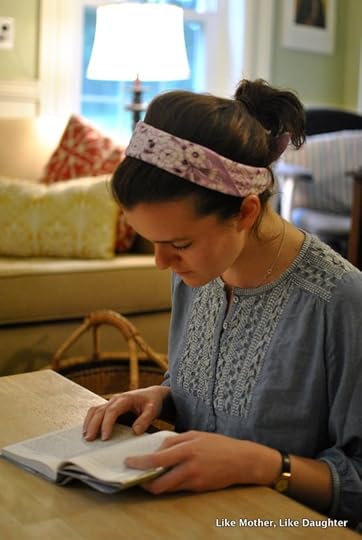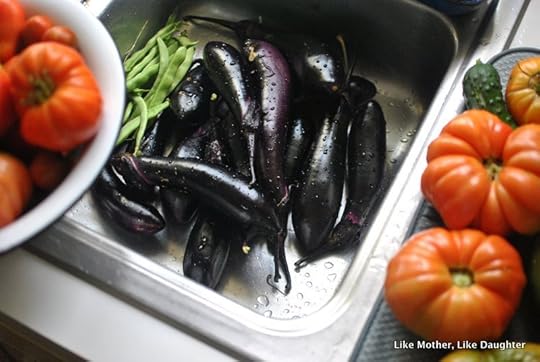{bits & pieces}
The weekly “little of this, little of that” feature here at Like Mother, Like Daughter!
If you ever wondered how I became a Christian, I will be on The Journey Home, Monday evening, Oct. 2, at 8pm. Marcus Grodi and I discuss my conversion story, and I reveal that I can’t subtract very well — I say that I was baptized on October 23, 1977, thirty years ago, sigh… You are so right to get your homeschooling advice from me! I hope you enjoy the program — let me know what you think! You can watch on the Coming Home Network website where the show will be archived, or on EWTN.
We are enjoying a little visit with Bridget, home for the weekend!

And the garden just keeps going, with a few beans, a cucumber or two, oodles of tomatoes, peppers, and eggplants, and just enough ground cherries to make me resolve to find them their own spot next year where they can really flourish! What is wrong with me! The usual… always trying to cram more plants into a small space. Also, not pictured, raspberries just all over the place.


On to our links!
Bridget introduced me to Richard Wilbur’s Love Calls Us to the Things of This World. This is a stunning poem that you have to read a couple of times (well, I did) to perceive its depth. In this video below (if you don’t see it, you’re probably in your email or feed reader — come to our actual page online or go here), brought to my attention by a fellow Wilbur admirer, the author reads his own poem in his deep, thoughtful voice.
It’s under four minutes and include’s the poet’s commentary — and it will be well worth watching after you have read, enjoyed, and absorbed the poem, maybe discussing it with your high schooler. What I want you to be sure to get said high schooler to see is that perhaps — just perhaps — Wilbur himself doesn’t quite get his own poem! This can happen and actually does happen with a true work of art; the art takes on a life of its own that the artist isn’t completely in control of. Anyway, I find it interesting that he points out (very charmingly) that it doesn’t seem to detract from the poem that it starts rather abruptly. I should say not! Isn’t the very abruptness a way that the disorientation of the waking person is conveyed? It’s so true and exactly how it is when we awaken to life that doesn’t quite focus from its various levels; and in this case, the reality of the poem is the further disorientation of witnessing the two realms, earthly and heavenly, colliding, and trying to wake up while reconciling them.
Is Roald Dahl worth reading? Educator Sean Fitzpatrick examines the question. “His vile villains, his suspenseful plots, and his superhuman children can desensitize sensitive minds, but it is that danger which makes the young engage eagerly to face the thrill and challenge of a fun and funny world that is far from antiseptic. The question remains, is Dahl worth the risk?” (Auntie Leila says read some of his popular books yourself, if you didn’t as a child… and know your own children. Not everyone has to read everything.)
An amazing church with an amazing, miraculous story.
The mystery of the lost Roman herb. Long, weird, and interesting.
Images of everyday life in Victorian England.
Fun — a terrarium, a sealed, enclosed ecosystem, that has been going for 80 years with virtually no interference.
A long political theory read: Since I did post a piece a while back, Adrian Vermeule’s Liturgy of Liberalism, I thought I would post this essay from Sohrab Ahmari warning against abandoning that school of politics, written in response to Vermeule’s critique: The Terrible American Turn Toward Illiberalism.
From the archives:
I spoke in Cambridge Massachusetts last week about praying in the home and the importance of moral development for children (which necessarily entails commitment from parents! Everyone pursues virtue!) . I have a series on that — and a few years ago, I wrote this post: Men without chests, or, what C. S. Lewis made me think about.
By the way, the quote comes from The Abolition of Man (which I wrote about here). C. S. Lewis’ essay is a densely packed tour de force of philosophical explication, ultimately a prophetic warning against adopting Kantian values. The fabulous C. S. Lewis Doodle artist has illustrated the first chapter here (and provided a list of the literary and other allusions here — scroll down).
Today is the feast of St. Jerome — a consolation to all the irascible Christians out there! There is hope even if you’re not super nice! And tomorrow, superseded by the Sunday — St. Thérèse, whom we can certainly remember in our private devotions!
~~~~~~
While you’re sharing our links with your friends, why not tell them about Like Mother, Like Daughter too!
We’d like to be clear that, when we direct you to a site via one of our links, we’re not necessarily endorsing the whole site, but rather just referring you to the individual post in question (unless we state otherwise).
Follow us:
Follow us on Twitter.
Like us on Facebook.
Auntie Leila’s Pinterest.
Rosie’s Pinterest.
Sukie’s Pinterest.
Deirdre’s Pinterest.
Habou’s Pinterest.
Bridget’s Pinterest.
Habou’s Blog: Corner Art Studio.
Auntie Leila’s Ravelry.
Auntie Leila’s Instagram.
Rosie’s Instagram.
Sukie’s Instagram.
Deirdre’s Instagram.
Bridget’s Instagram.
Habou’s Instagram.
The post {bits & pieces} appeared first on Like Mother Like Daughter.



